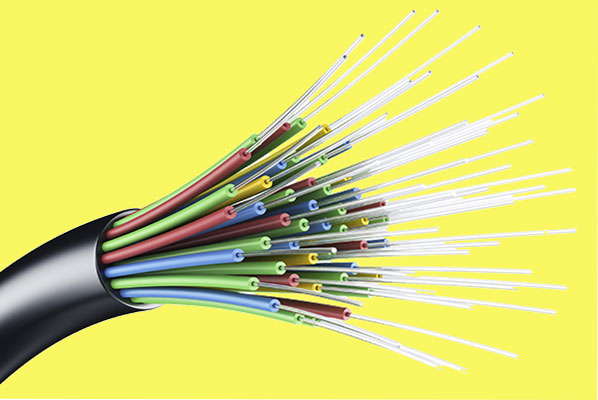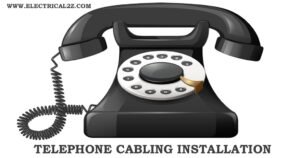Table of Contents
Fiber Optic Cable
What is Fiber Optic Cable | Fiber optic communications is moving forward on both land and sea. For example, the latest fiber optic submarine cables have amplifiers placed approximately 30 miles apart. The amplifiers are made by exciting a strand of coiled-up glass fibers containing a small percentage of the element erbium.
 |
| What is Fiber Optic Cable 1.1 |
An external, electrically powered laser beam bathes the fiber. The excited erbium atoms release their energy in step with the oncoming signal, sending the signal on its way stronger than before. Such optical amplifiers have been in use since the early 1990s, replacing electronic amplifiers that were much slower.
It has now been learned that independent streams of information can be sent through a single fiber by using a different color for each channel. Researchers at Lucent Technology Bell Labs have announced that they have pushed 1.6 trillion bits, or terabits, of information through a single fiber. This was accomplished by splitting the light beam into 40 different colors, sufficient for sending 25 million conversations or 200,000 video signals at the same time.
One cable may contain a dozen such fibers. Transmission speed has been doubling every year, and next year it is expected to double again and the year after that.
Fiber optic cables are expensive when it comes to placing them under the sea or burying them underground, in just one project, Tyco paid US$1 billion to add two new cables between Japan and the United States (West Coast). Project Oxygen, a rival network, raised US$10 billion for a 100,000-mile network completed in 2003.
There are 96 landing points in 75 countries and territories in the 100,000 miles of cable. An industry analyst who tracks the industry figures says, US$31.8 billion was spent between 1999 and 2004. Many schools and universities and some homes are being wired with fiber optics for future use. Electricians are being called on to make sure the cable is properly installed. That means it must be installed according to the local codes, and most of the local codes are based on the National Electrical Code (NEC).
Article 770 of the NEC deals with the proper installation of fiber optic cables and raceways. The main concern of the Code is the spread of fire and products of combustion. Ducts, plenums, and other air-handling spaces must be carefully taken into consideration when installation of the cable is proposed in any type of building. Most people will not have fiber optic lines directly to their homes because of the installation cost.
National Electrical Code on Fiber Optic Cable
Optical fiber cables and raceways are covered by the NEC in Article 770. The provisions of this article are in reference to optical fibers and raceways, but do not cover the construction of optical fiber cables or raceways. The circuits and equipment must comply with 770-2 (a) (b). Ducts, plenums, and other air-handling spaces are covered in Section 300-22, and 300-21 deals with the spread of fire or products of combustion as related to optical fiber cables in raceways.
A study of the information in 770-53 of the Code deals with the installation of the cable in raceways.
Fiber Optic Cables
Optical fiber cables are made up of devices connected in a way that makes it possible to transmit light very efficiently through them for the purposes of control, signaling, and communications. There are three types of optical fiber cables:
• Nonconductive. These cables contain no metallic members or other electrically conductive materials.
• Conductive. These are cables that contain non-current-carrying conductive members such as metallic strength members and metallic vapor barriers.
• Composite. Cables that contain both optical fibers and current carrying electrical conductors are permitted to contain noncurrent- carrying conductive members such as metallic strength members and metallic vapor barriers.
• Composite optical fiber cables are classified as electrical cables in accordance with the type of electrical conductors contained therein.
Raceways
With one exception, a raceway system designed for enclosing and routing only nonconductive optical cables must be of a type permitted in Chap. 3 of the Code and installed in accordance with Chap. 3. Cables are classified according to types. The use of letters to designate the cables makes it easier to refer to them accurately and with a minimum of space.
Cable Markings
Cables marked nonconductive optical fiber plenum (OFNP) and conductive optical fiber plenum OFCP, can be used in ducts, plenums, and other space carrying for environmental air. The cables must have adequate fire-resistant and low smoke-producing characteristics.
 |
| OFC Cable |
Types OFNR and OFCR are designed for use in risers. They are suitable for use in a vertical run in a shaft or from floor-to-floor, and are listed as having fire-resistant characteristics capable of preventing the spread of fire from
floor-to-floor.
Cables labeled OPNG and OFCG are cables that can be used for general purposes, with the exception of risers and plenums, and in situations where resistance to the spread of fire is desired. The OFN and OFC types of cables are suitable for general purpose use with the exception of risers, plenums, and other space that may be used for environmental air.
Section 770-52 of the Code deals exclusively with the installation of optical fibers and electrical conductors. Part (a) deals with conductors for electrical light and power circuits and class 1 circuits. Optical fibers may be used where the same composite cable for electrical light and power or class 1 circuits operating at 600 volts or less is used.
Twisted Pair Cable Color Code. This system has tip colors, ring colors, group colors, and binder colors. The twisted-pair color code is used to identify the number of a pair within a cable. For example, a pair in the orange-Yellow binder group that is Yellow-Green is pair 418 (O–Y+Y–O). The twisted-pair color code in our telephone network is shown in table.
Binders
A binder is a plastic ribbon wrapped around 25 pairs of wire or 600 pairs of wire. Binder codes are identifying groups of 25 or 600. The binder code is the same as the pair code, only the group colors and the pair colors are reversed (e.g., white-blue becomes blue-white), so when the abbreviated colors are put together, they are easier to understand. Binder codes are good for 600 pairs of wire. After that, each group of 600 pairs gets an additional plastic binder.
Large cable binders:
• Pair 1 to 600, surrounded by a white binder
• Pair 601 to 1200, surrounded by a red binder
• Pair 1201 to 1800, surrounded by a white binder.
Final Word



